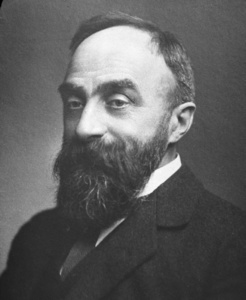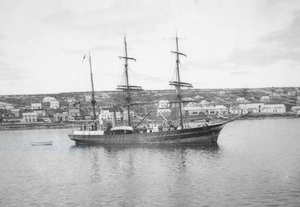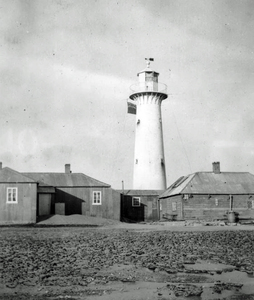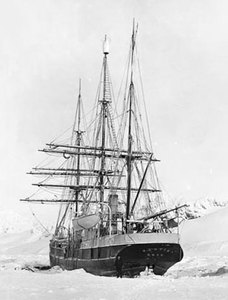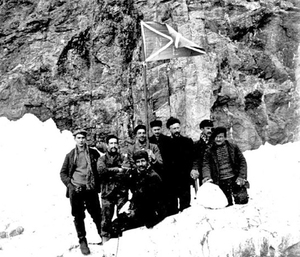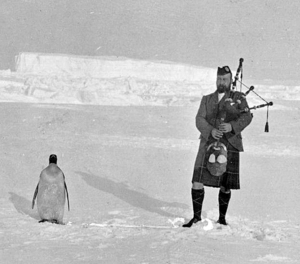BRUCE, WILLIAM SPEIRS
1867 - 1921 from England (also Scotland)
explorer, was born in London on 1 August 1867 the son of Samuel Noble Bruce and his wife Mary (Sara), née Lloyd.
His father was at that time working in London as a physician, as William's grandfather had moved south to London in 1851 and Bruce went to Norfolk County School and then on to study medicine at London University. This was a result of his father's pressure because his real interest was in natural science, to which he had been introduced by Professor Patrick Geddes during his holidays.
He quickly changed from London to Edinburgh so that he could study biology and oceanography under Geddes. Bruce also became involved in the research which was being carried on in Geddes's floating laboratory in Granton Harbour on the Firth of Forth, appropriately known as 'The Ark'.
His residence in Edinburgh brought him into contact with two people who would influence his life enormously, firstly HR Mill, later the distinguished librarian of the Royal Geographical Society, and secondly, WG BURN-MURDOCH, a painter, with whom he shared a room. It was Burn-Murdoch who persuaded him to go on the Balaena expedition.
The Dundee whaling expedition of 1892-3 (Balaena) confirmed Bruce's interests in Polar regions and their biology and oceanography. It was on this expedition that he made his first visit to the Falkland Islands. In his book From Edinburgh to the Antarctic Burn-Murdoch wrote some very vivid accounts of life on the Islands which he described as 'very homely and just like Shetland'. The bird life made an enormous impact on Bruce as did the large number of wrecks lying in the harbour which all told 'of some storm, gale and narrow escape - the dismal side of sea life'. As the Balaena was the first of the four ships to arrive Bruce had time to do some research, and Burn-Murdoch describes him as 'disappearing with flowing mackintosh, vascular, geological hammer, Jaeger snow cap and shooting boots - the perfect Antarctic pytheas'. There is another vivid description of Bruce playing his pipes in a potato patch. The Balaena returned again to the Falkland Islands on 27/28 February 1893 when Bruce was amazed to find himself eating gooseberries and redcurrants in February. The expedition was a slight disappointment to Bruce as whaling very much took precedence over science.
On his return to Scotland, Bruce applied for the job of assistant meteorological observer at the meteorological station placed on the summit of Ben Nevis. He left this job when, in 1896, he was asked to become a member of the Jackson Harmsworth expedition to Franz Josef Land, which was then in its second year. Arctic exploration was very much in fashion and this fashion spread to the Antarctic as a result of the Sixth International Geographical Congress in 1895. The next seven years were to see seven major expeditions - two English, one Swedish, one German, one Belgian, one French and - thanks to Bruce - one Scottish.
When Bruce launched the Scottish National Antarctic expedition, it was highly disapproved of by the Royal Geographical Society in London and no finance was forthcoming from the British Government. Bruce therefore was financed more or less entirely by the Coats thread manufacturing family, who won immortality with the discovery of Coats Land. The Scottish expedition was extremely well planned and highly successful in achieving its scientific objectives. It cooperated closely with Drygalski and NORDENSKJOLD to make sure they did not overlap on research of oceanographical and meteorological matters.
During the Scottish expedition Bruce visited the Falkland Islands again, firstly from 30 December 1902 to 26 January 1903. The account of the expedition makes little comment on the Islands except to mention the tremendous help they received from the Royal Navy's ships Cambria and Basilisk and the high price of coal. Bruce returned to the Falkland Islands with the Scotia on 2 December 1903, staying until 9 December. He again commented on the great help he received and the kindness and hospitality and on the smell of burning peat which hung in the air and made many of them feel at home.
On his return to Scotland, Bruce immediately set up an oceanographic laboratory at Leith, modelled on the one set up by his friend the Prince of Monaco, in Monaco. But he was completely captivated by polar exploration and he proposed the crossing of the Antarctic continent in 1910/11. Finance was not forthcoming but the idea was taken up by Ernest SHACKLETON who was at that time secretary of the Royal Scottish Geographical Society. The rest of Bruce's life was spent in arctic expeditions, leading a series of visits up to Spitzbergen. He formed the Scottish Spitzbergen Syndicate whose purpose was to try to extract coal commercially. This was not a success.
Bruce married Jessie Mackenzie in 1901 and they had two children: Eillium Alastair (b1902) and Sheila Mackenzie (b1909). He wrote a large number of articles on polar themes as well as the seven-volume report on the scientific results of the Scotia expedition.
He died in Edinburgh on 28 October 1921 and was remembered by all those who knew him as a man of exceptional kindness. His philosophy of life was 'to lift the veil from the unknown, to add to human knowledge in the belief that all knowledge is of value'.
See: Image 67
Editorial comment:
Phil Stone writes: In later years, Bruce became increasingly embittered at the lack of support and recognition accorded to the SNAE by the British Antarctic Establishment. Despite the expedition’s friendly reception in Stanley, that bitterness came to cloud his memories of the Falkland Islands such that he would later write “I had to take Scotia herself to Buenos Aires where I got coal at half the price and regret very much that owing to this I was driven out of a British Colony and forced to refit in a foreign country.” (Letter from Bruce to Sir Thomas Holdich, 15 March 1910).
External links
See: The papers of William Spiers Bruce - held at the Univeristy of Edinburgh Special Collections
See: William Spiers Bruce
See: Polar Exploration - by WIlliam Spiers Bruce (full text of the book)
References
Peter Speak; William Speirs Bruce: Scottish Nationalist and Polar Explorer. The Polar Record Vol. 28 no. 167 October 1992 p285-292.
Peter Speak; William Speirs Bruce: Scottish Nationalist and Polar Explorer.
Bernard Stonehouse, ed; Encyclopaedia of Antarctica and the Southern Oceans. Chichester: John Wiley & Sons.
Phil Stone; Scientific work in the Falkland Islands by the Scottish National Antarctic Expedition 1903 & 1904; Falkland Islands Journal; 2017. (see: Full text of article)
Phil Stone; The Scottish Polar Explorer William Bruce (1867-1921) and his thwarted ambitions in the Falkland Island Dependencies ; Falkland Islands Journal; 2023; pp35-50
Comments
Revisions
June 2019 Additional photograph added
November 2019 Additional photograph added; three external links added; three references added
January 2020 One additional reference added; two additional photographs added
November 2021 One additional photograph added; an editorial comment added
